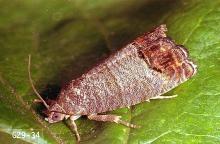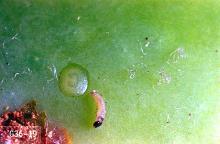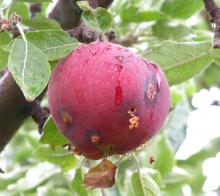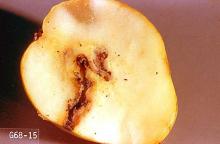Cydia pomonella
Pest description and crop damage The codling moth is the most serious direct pest of apples in commercial and home orchards in the PNW. Wild populations are rampant in many areas of the PNW, and most apple varieties are heavily damaged without protection. Larvae bore into the fruit, often through the calyx or areas of contact between adjacent fruit. Larvae feed toward the core, leaving a characteristic tunnel filled with frass that often leads to fruit rotting. Larvae that die in the process of penetrating fruit can leave stings, which are shallow wounds in the fruit skin. In most regions of the PNW there are two damage periods; first the young fruitlets are attacked, and later the mature fruit.
Biology and life history The codling moth overwinters as mature larvae in silken cocoons (hybernacula) spun under loose bark, in the soil, or in litter at the base of the tree. Pupation takes place in the spring around the time the first blossoms are showing pink, and adults emerge around bloom of cv. 'Red Delicious'. There are typically two generations per year. Adults are mostly active at dusk and dawn and they can disperse over considerable distances. Females lay eggs on leaves and fruit.
Larvae wander to fruit and begin chewing through the skin and tunneling to the center of fruit to feed on the flesh and seeds. As they mature, they push frass out of the entry hole. After 3 to 4 weeks, the larvae leave the fruit to seek a sheltered spot on the tree or leaf litter to spin cocoons. Fruit infested by larvae may drop prematurely.
Larvae may overwinter in the cocoon, or they may emerge in 2 to 3 weeks as a new flight of adults. These adults are active in July and August. In areas that accumulate more heat units, there may even be a third generation. Larvae of this latter generation penetrate fruit but may not have enough time to complete development before harvest or the onset of winter.
Sampling and thresholds The development of the codling moth can be predicted by the accumulation of heat units, or degree-days, using phenology models. By knowing the stage of the insect, we can target management to specific life stages that are susceptible. For the codling moth, treatments against the eggs or the wandering larvae (during the brief period between egg hatch and the time when the larva is able to penetrate the fruit where it is protected) are the most effective. Phenology model recommendations can originate with your local Extension resource, crop consultant, software system, or use of an online degree-day calculator. It is important to make sure that you are using an appropriate tool/model for your region. Accurate weather data representing your orchard is very important. Homeowners can also benefit from use of degree-day models to predict management timing.
To calculate biofix for degree-day modeling, hang traps with 1 mg pheromone lures in the upper canopy in early spring (before blossoms reach pink stage). Biofix is the first capture of multiple male moths in a trap or consistent capture of multiple males over more than one trap. The biofix date is used as the point to start accumulating degree-days for the Brunner and Hoyt (1987) degree-day model, which is still the best model for PNW locations south of 46°N. North of this latitude, the no-biofix model can be used (Jones et al. 2008). It is important to note that the two models have different degree day accumulations for key events in the codling moth life cycle. The CM-DA lure contains a fruit odor and will catch females as well as males. Capture of females indicates potential for eggs and damage, but models can also use male captures for setting biofix. It is important to note that trap captures do not always reflect the potential for damage and the best approach for management is to integrate different strategies.
Management-biorational control
A number of commercial pheromone dispensers including hand applied dispensers and aerosol emitters are available to disrupt mating of codling moth. Apply pheromone dispensers or aerosol devices to the orchard well ahead of bloom. The codling moth population must already be at a low level for the technology to be effective. The orchard should be relatively large and without a high edge to core ratio. When mating disruption is used, monitor the orchard with pheromone traps baited with 1 mg lures to measure mating disruption effectiveness, and 10 mg pheromone or CM-DA lures set in the upper third of the canopy. If more than five male moths are captured in a trap over the first generation, check the orchard for fruit damage or apply a conventional insecticide. If fruit damage exceeds 0.5% at the end of the first generation, use conventional insecticides to provide supplemental control against the second generation. If more than two male moths are captured in a trap during the second generation, a conventional insecticide may be necessary.
Management-cultural control
Thinning fruit clusters to reduce the number of contact points between fruits may help reduce larval success rates for penetrating fruits. In small orchards, sanitation by removing and disposing of young, damaged fruit can be helpful in reducing codling moth populations. Check regularly throughout the season for fruit with frass-filled holes. Removing and destroying infected fruit prior to larvae emergence preceding pupation can help reduce overall populations. Picking up dropped fruit from the ground likewise can be an effective sanitation measure. Homeowners can bag individual fruit (clusters thinned to one fruit) in paper or mesh bags approximately six weeks after bloom, however this can be labor-intensive and more challenging for cultivars with short stems. Fruit will mature completely within bags, however color development on red varieties may be affected. Homeowners can also place corrugated bands of cardboard around the lower trunk to attract larvae looking for a place to pupate. Place bands in May and remove before the adults begin to emerge in mid-June. The same technique can be used for the subsequent generation(s) later in summer.
Management-chemical control: HOME USE
After petal fall spray and spring and summer sprays
Apply first cover spray at 250 degree-days after biofix (or 225 degree-days if the selected insecticide has ovicidal activity), or about 10 days after full petal fall (all petals are off) or 17 to 21 days after full bloom. Insecticides are timed to target eggs and newly hatched larvae before they bore into the fruit. Multiple sprays are often necessary, but spray timing can be improved by monitoring for adult moths with pheromone-baited monitoring traps or use of degree-day models (see description above) to properly time insecticide applications to the hatching larvae during the growing season.
- acetamiprid
- gamma-cyhalothrin-Highly toxic to bees.
- insecticidal soap-Some formulations OMRI-listed for organic use.
- kaolin-Applied as a spray to leaves, stems, and fruit, it acts as a repellant to pests. OMRI-listed for organic use.
- lambda-cyhalothrin-Highly toxic to bees.
- malathion-Highly toxic to bees.
- mating disruption pheromones-See biorational control above. Not a good option for small home orchard blocks, may increase damage.
- permethrin-Highly toxic to bees.
- pyrethrins (often as a mix with other ingredients) -Highly toxic to bees.
- spinosad (Entrust) -Some formulations OMRI-listed for organic use.
- zeta-cypermethrin-Highly toxic to bees.
Management-biorational control: COMMERCIAL USE ONLY
Stages 5-6: Pink application
Mating disruption. Pheromone release devices placed in the orchard interfere with the communication from female to male codling moth and this prevents or delays mating of moths, reducing the number of eggs laid and resultant crop damage. A number of hand-applied pheromone dispensers are available including Isomate C+, Isomate CTT, NoMate, CheckMate, Cidetrak CM, and Checkmate CM-XL 1000. These dispensers are typically applied to trees at densities of 200 to 400 per acre, sometimes with a higher density of dispensers applied to orchard borders. Research has shown that the most effective rate is 400 dispensers per acre. Aerosol devices for releasing pheromones are increasingly favored for their ease of application at densities of one device per acre. Substantial fruit damage could result from improper use of mating disruption, therefore follow the label recommendations. Blocks placed under mating disruption should be large, ideally greater than 10 acres, and prospects for success increase when neighboring orchards are also using the tactic and the codling moth pressure is already low. Pheromone dispensers can be most easily applied to dormant trees and must be in place before first moth flight around the time of full bloom of 'Red Delicious'. Place within 2 ft of the top of the canopy. If the orchard has a history of codling moth problems, use one or more insecticide applications against the first generation. If a codling moth source exists nearby, use border sprays (five to six rows) of insecticides.
Management-biological (microbial) control: COMMERCIAL USE ONLY
- codling moth granulosis virus (Cyd-X, Virosoft CP4)-Check label for rates. REI 4 hr. PHI 0 day. Granulosis virus is a selective biological insecticide that must be ingested to be effective. Thorough coverage is important. The virus degrades when exposed to UV light. If a grower relies only on granulosis virus for codling moth control, frequent applications are necessary (every 7 to 10 days), especially when codling moth pressure is high. The virus controls larvae, but some fruit damage, primarily stings, may be evident. OMRI-listed for organic use.
Management-chemical control: COMMERCIAL USE
After petal fall spray
Apply first cover spray at 250 degree-days after biofix, or earlier for ovicidal materials such as oil and growth regulators (225 degree-days). Note that many materials can be mixed with horticultural oil for increased activity against eggs and increased efficacy. This timing roughly corresponds to about 10 days after full petal fall (all petals are off) or 17 to 21 days after full bloom for 'Red Delicious'. A second treatment is recommended approximately 14 days after the first (depending on residual) to cover the full period of moth egg laying in the first generation. The first summer generation spray should be applied at 1250 degree-days after biofix, and again a second treatment in 14 days will help cover the entire egg hatch period. Materials with rapid breakdown such as codling moth granulosis virus should be applied on a more frequent schedule.
- chlorantraniliprole (Altacor) at 3.0 to 4.5 oz/A in no less than 100 gal water per application. Do not apply more than 9 oz/A per growing season. Do not use an adjuvant within 60 days of harvest. REI 4 hr. PHI 5 days. [Group 28] [ovicidal and larvicidal]
- cyantraniliprole (Exirel) at 10 to 17 fl oz/A in up to 100 gal water per application. Apply just prior to egg hatch. REI 12 hr. PHI 3 days. [Group 28]
- horticultural mineral oil
- methoxyfenozide (Intrepid 2F) at 16 fl oz/A in up 100 gal water per application. For use against low- to moderate-pressure situations, with alternate control measures such as mating disruption. Use adjuvant; see label. Do not exceed 64 oz/A per growing season. REI 4 hr. PHI 14 days. [Group 18]
- novaluron (Rimon) at 30 to 50 fl oz/A in up to 100 gal water per application with a second application 14 to 17 days later. Do not apply more than 150 fl oz per growing season. REI 12 hr. PHI 14 days. [Group 15]
- pyriproxyfen (Esteem 35WP) at 4 to 5 oz/A in up to 100 gal water per application. Do not exceed two applications per season. Do not apply earlier than 14 days after last Esteem 35 WP treatment. REI 12 hr. PHI 45 days. [Group 7C]
Spring and summer
- acetamiprid (Assail 70WP) at 1.7 to 3.4 oz/A in up to 100 gal water per application. Do not make more than four applications per year or exceed 13.5 oz/A per growing season. Adding a low rate of horticultural mineral oil improves effectiveness against codling moth. REI 12 hr. PHI 7 days. [Group 4A] [ovicidal and larvicidal]
- Chromobacterium subtsugae (Grandevo) at 1 to 3 lb/A. Under heavy pest populations, apply a knockdown insecticide prior to or in a tank mix, use the higher label rates, shorten the spray interval, and/or increase the spray volume to improve coverage. REI 4 hr. PHI 0 day. OMRI-listed for organic use.
- clothianidin (Belay) at 6 fl oz/A. For control of first generation codling moth in areas with light pressure and suppression of first generation codling moth in areas of heavy infestation. Do not apply more than 12 fl oz of Belay per acre per season. REI 12 hr. PHI 7 days. Do not feed or allow livestock to graze on cover crops from treated orchards. Belay must not be applied during bloom or if bees are actively foraging. [Larvicidal].[Group 4A]
- chlorantraniliprole (Altacor) at 3.0 to 4.5 oz product/A in no less than 100 gal water per application. Do not apply more than 9 oz per acre per growing season. Do not use an adjuvant within 60 days of harvest. REI 4 hr. PHI 5 days. [Group 28] [ovicidal and larvicidal]
- cyantraniliprole (Exirel) at 10 to 17 fl oz/A in up to 100 gal water per application. Apply just prior to egg hatch. REI 12 hr. PHI 3 days. [Group 28]
- emamectin benzoate (Proclaim 5SG) at 3.2 to 4.8 oz/A in up to 100 gal water per application. For use in low to moderate pressure situations with alternate control measures such as mating disruption. Do not exceed 14.4 oz/A per season. REI 12 hr (48 hr for workers performing propping, pruning, thinning and tying). PHI 14 days. [Group 6] [larvicidal]
- fenpropathrin (Danitol 2.4 EC) at 16 to 21.3 fl oz/A in up to 100 gal water per application. Will also reduce mite populations but may cause resurgence the same season. Do not exceed 42.7 fl oz per acre per season. REI 24 hr. PHI 14 days. [Group 3]
- granulosis virus (CYD-X, CYD-X HP, Virosoft CP4)- Check label for rates. Start at the beginning of first generation egg hatch. Apply every 7 to 10 days. REI 4 hr. PHI 0 day. [larvicidal] OMRI-listed for organic use.
- indoxacarb (Avaunt) at 5 to 6 oz/A in up to 200 gal water per application. Make no more than three applications prior to hand-thinning. No hand thinning after the fourth application. Make no more than four applications per growing season. Do not apply more than 24 oz/A per growing season. For use in low- to moderate-pressure situations, with alternate control measures such as mating disruption. REI 12 hr. PHI 14 days. [Group 22]
- methoxyfenozide (Intrepid 2F) at 16 fl oz/A in up to 100 gal water per application. For use against low- to moderate-pressure situations, with alternate control measures such as mating disruption. Do not exceed 64 oz/A per season. REI 4 hr. PHI 14 days. [Group 18] [ovicidal and larvicidal]
- novaluron (Rimon) at 30 to 50 fl oz/A in up to 100 gal water per application. See label for application timing. Do not exceed 150 fl oz/A per season. REI 12 hr. PHI 14 days. [Group 15] [ovicidal]
- phosmet (Imidan 70W) at 2.1 to 5.7 lb/A in up to 100 gal water per application. REI/PHI 7 days. [Group 1B]
- pyriproxyfen (Esteem 35WP) at 4 to 5 oz/A in up to 100 gal water per application. Do not exceed two applications per growing season. REI 12 hr. PHI 45 days. [Group 7C] [ovicidal]
- spinetoram (Delegate WG) at 6 to 7 oz/A in up to 100 gal water per application. Do not exceed four applications per season. REI 4 hr. PHI 7 days. [Group 5] [larvicidal]
- spinosad (Entrust 80WP) at 2 to 3 oz /A in up to 100 gal water per application. Do not exceed 9 oz/A per season. REI 4 hr. PHI 7 days. OMRI-listed for organic use. [Group 5] larvicidal]
- thiamethoxam/chlorantraniliprole (Voliam Flexi) at 4 to 7 oz/A in up to 100 gal water per application. Do not apply exceed 16 oz/A per season and do not use an adjuvant within 60 days of harvest. REI 12 hr. PHI 35 days. [Group 4A & 28] [ovicidal and larvicidal]





